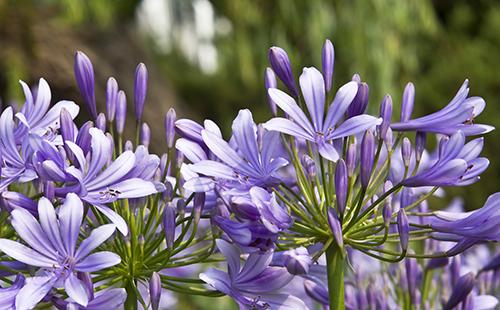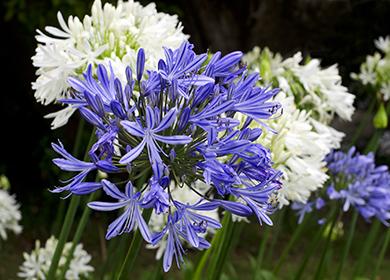The content of the article
Belongs to the genus of herbaceous perennials of the agapanthus family. Agapanthus used to belong to the lily family. With a change in classification, about ten varieties of plants were assigned to agapanthus.
Plant description
The roots are tightly braided by an earthen lump, fleshy, mostly superficial. Over the soil, thick basal rosettes form. The leaves are dark, belt-shaped, rather long - about half a meter or more. The bush is spherical, neat, looks expressive even without flowering.
Deciduous and evergreen varieties grow in nature. It begins to bloom at the very beginning of summer. A fleshy peduncle appears from the central part of the outlet. It is quite high - on average about 40 cm. In rare cases, it extends up to one and a half meters. The flower stalk is naked, smooth, on its crown a dense, rather large spherical inflorescence is formed. Each bud is held on a separate thin stalk. The flowers are bell-shaped, delicate colors - blue and lavender tones.
Blossom continues until mid-autumn. After flowering, a fruit is tied - a box with seeds. Their ripening lasts up to one and a half months. Seeds are dark brown, flat, numerous.
Popular varieties
Growing agapanthus at home begins with the selection of a suitable variety. Not all types feel equally good in an apartment. Preference is given to the three most common varieties.
- Umbrella. The most popular variety, called the African lily. Evergreen perennial. The plant is up to 70 cm high. The leaves are dark, belt-shaped. Peduncle high with an umbrella inflorescence at the top. The flowers are blue or white.
- Oriental. Evergreen herbaceous perennial. It differs from other species in a wider and fleshy foliage. The flowers are pale blue.
- Bell-shaped. Perennial with linear leaves. The flowers are not very large, resemble bells, a predominantly blue hue.
Post-purchase measures
How to care for agapanthus after purchase? This is a rather delicate plant, sensitive to a change in microclimate. To make agapanthus easier to take root in a new place, it is recommended to follow simple rules.
- Do not hurry. Do not remove the flower from the package immediately after purchase. Leave it alone for a couple of hours to smooth out the temperature drop. Especially if you bought it in the winter.
- Quarantine. For ten days, you need to stay on a flower - put it separately from other flowers. Why is this done? Perhaps the store overlooked the initial signs of the disease or pests.New plants in the house always pose a danger to the rest of the flower collection.
- Sparing mode. Do not feed, water moderately, only as necessary. Keep agapanthus in diffused lighting, in a room with a neutral temperature of 22-24 ° C. Try not to move or touch it again.
- Treatment. Just in case, as a prophylaxis, treat agapanthus with fungicides and insecticides in a low concentration.
- Transfer. Transport soil is not suitable for continuous cultivation. Immediately after quarantine, carefully transfer the agapanthus into a suitable pot with a good, sterile soil.
Accustomed to the new environment, transplanted, treated from diseases and pests, the flower can be put to the rest of the plants. Accustom it to the standard care regimen gradually.
Agapanthus care: what to consider
Caring for agapanthus (African lily) in a pot can not be called very simple or very difficult. In general, the plant is not capricious, but from improper care it gets sick and loses its decorative effect. Therefore, it is recommended to adhere to a number of rules.
- Lighting. Proper lighting is very important for agapanthus. With a lack of light, flower stalks become brittle, frail. Not afraid of direct sunlight - can be grown on the south window. In winter, the lack of light is compensated by the installation of fluorescent lamps.
- Temperature. Depending on the season, the requirements for the temperature regime change. In summer, he easily tolerates the heat, prefers to be in the fresh air - if possible, agapanthus is taken out to the balcony or to the garden. In autumn, the temperature is reduced, in winter they are kept in a bright room at 12 ° C.
- Watering. Watering agapanthus in the summer is recommended regularly and quite abundantly. In the cold season, watering is limited to a minimum, but carefully monitor the flower. In the cold, with a lack of moisture, it can discard leaves.
- Humidity. Agapanthus is indifferent to the level of humidity. Normally grows in low and high humidity. Spraying is used only to remove dust from leaflets.
- The soil. Choose light, nutritious, breathable soil. The optimal composition is two parts of turf and humus, one part of leafy soil and sand.
- Top dressing. Mostly mineral fertilizers are used. It is possible to feed organics, but in a very limited amount and not more than once every three months. The frequency of application of mineral complexes is twice a month throughout the entire vegetative period.
- Transfer. Young specimens are not recommended to disturb. You can transplant agapanthus in case of emergency - if you need to change the damaged soil, the roots are rotted or they become very crowded in the pot. Transplantation is allowed no more than once in three to four years. It has very fragile, brittle roots.
How to propagate
Agapanthus (African lily) can be propagated by seeds and shares. For sowing, it is better to use store seeds, there is a likelihood of losing varietal characteristics.
Seed sowing
Agapanthus seeds are sown in March. For successful cultivation of seedlings adhere to the following sequence.
- Boxes are filled with light sand and peat substrate.
- The soil is moistened, seeds are buried in it by 1 cm.
- The box is covered with polyethylene. Every day the greenhouse is ventilated for half an hour.
- Periodically moisten the soil, maintain a temperature of 16-20 ° C.
The first shoots appear in one to two weeks. Seedlings can be planted in a separate container after the formation of four true leaves. Seed plants develop slowly - the first flowering will come in five to seven years.
Bush division
This method allows you to get several plants at once, which will bloom next year. Divide the bush in autumn or spring, but not during the flowering period. The following steps are followed.
- The bush is carefully removed from the pot, the roots are completely freed from the soil.
- With a clean sharp knife, the bush is cut into pieces, leaving at least one leaf rosette on each dividend. Slices are immediately treated with carbon powder.
- For two to three days, delenki is simply covered with a moist substrate.
- Three days later, agapanthus delicins are planted in separate pots in a permanent place.
- In the early days, until signs of growth appear, they adhere to limited watering.

Table growing problems
Diseases, pests, errors of care - all this affects the condition and decorativeness of agapanthus. To determine what is wrong with agapanthus, just look at the table.
Table - Difficulties in growing agapanthus
| A problem | Possible reasons | What to do |
|---|---|---|
| Yellowed leaves | - Unregulated watering; - systematic waterlogging of the soil | - Adjust your watering schedule |
| Agapanthus does not bloom | - A large pot; - excess nitrogenous fertilizers; - excess organic matter in the soil; - deep landing; - warm wintering | - Determine the cause and adjust the care regimen |
| Peduncles are pulled | - lack of lighting | - Rearrange to the south window |
| Leaves dry and fall | - Spider mite; - shield | - Make sure the cause is insects; - spray with Actellik |
| Roots and root neck rot | - Fungus; - soil moisture | - Reduce watering; - transplant with the removal of rotten areas; - treat with fungicides |
| Leaves dry, dots and cobwebs appear on them | - Spider mite | - Increase the humidity in the room; - spray with the preparation "Inta-vir" or "Actellik" |
Knowing how to care for agapanthus, observing all the recommendations above, you can achieve a high decorative plant. Beautiful, large hats of delicate blue agapanthus flowers will decorate any interior.

